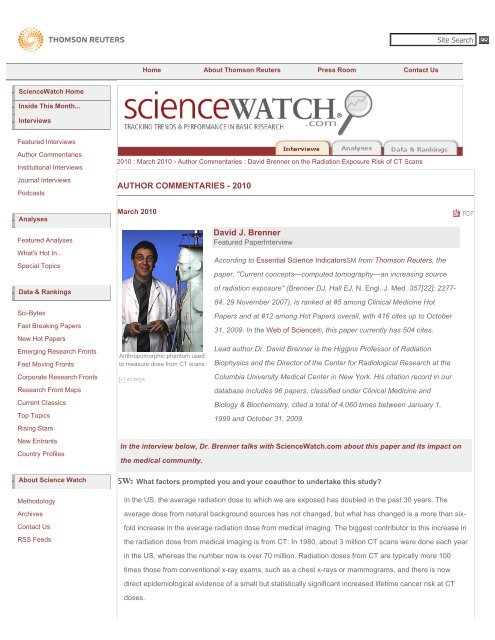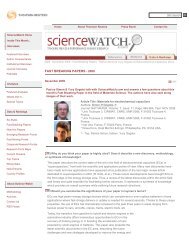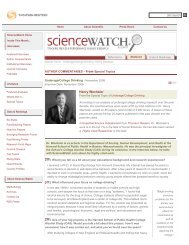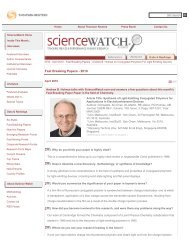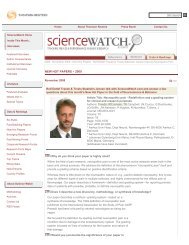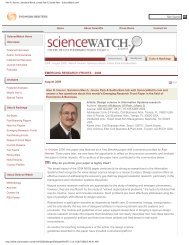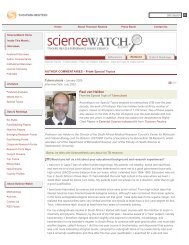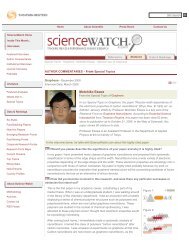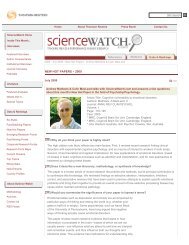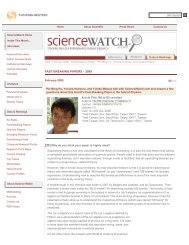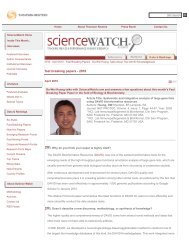David Brenner on the Radiation Exposure Risk of CT Scans ...
David Brenner on the Radiation Exposure Risk of CT Scans ...
David Brenner on the Radiation Exposure Risk of CT Scans ...
Create successful ePaper yourself
Turn your PDF publications into a flip-book with our unique Google optimized e-Paper software.
Home About Thoms<strong>on</strong> Reuters Press Room C<strong>on</strong>tact Us<br />
●<br />
●<br />
●<br />
ScienceWatch Home<br />
Inside This M<strong>on</strong>th...<br />
Interviews<br />
Featured Interviews<br />
Author Commentaries<br />
Instituti<strong>on</strong>al Interviews<br />
Journal Interviews<br />
Podcasts<br />
2010 : March 2010 - Author Commentaries : <str<strong>on</strong>g>David</str<strong>on</strong>g> <str<strong>on</strong>g>Brenner</str<strong>on</strong>g> <strong>on</strong> <strong>the</strong> Radiati<strong>on</strong> <strong>Exposure</strong> <strong>Risk</strong> <strong>of</strong> <strong>CT</strong> <strong>Scans</strong><br />
AUTHOR COMMENTARIES - 2010<br />
●<br />
●<br />
Analyses<br />
Featured Analyses<br />
What's Hot In...<br />
Special Topics<br />
Data & Rankings<br />
Sci-Bytes<br />
Fast Breaking Papers<br />
New Hot Papers<br />
Emerging Research Fr<strong>on</strong>ts<br />
Fast Moving Fr<strong>on</strong>ts<br />
Corporate Research Fr<strong>on</strong>ts<br />
Research Fr<strong>on</strong>t Maps<br />
Current Classics<br />
Top Topics<br />
Rising Stars<br />
New Entrants<br />
Country Pr<strong>of</strong>iles<br />
March 2010<br />
Anthropomorphic phantom used<br />
to measure dose from <strong>CT</strong> scans.<br />
<str<strong>on</strong>g>David</str<strong>on</strong>g> J. <str<strong>on</strong>g>Brenner</str<strong>on</strong>g><br />
Featured PaperInterview<br />
According to Essential Science IndicatorsSM from Thoms<strong>on</strong> Reuters, <strong>the</strong><br />
paper, "Current c<strong>on</strong>cepts—computed tomography—an increasing source<br />
<strong>of</strong> radiati<strong>on</strong> exposure" (<str<strong>on</strong>g>Brenner</str<strong>on</strong>g> DJ, Hall EJ, N. Engl. J. Med. 357[22]: 2277-<br />
84, 29 November 2007), is ranked at #5 am<strong>on</strong>g Clinical Medicine Hot<br />
Papers and at #12 am<strong>on</strong>g Hot Papers overall, with 416 cites up to October<br />
31, 2009. In <strong>the</strong> Web <strong>of</strong> Science®, this paper currently has 504 cites.<br />
Lead author Dr. <str<strong>on</strong>g>David</str<strong>on</strong>g> <str<strong>on</strong>g>Brenner</str<strong>on</strong>g> is <strong>the</strong> Higgins Pr<strong>of</strong>essor <strong>of</strong> Radiati<strong>on</strong><br />
Biophysics and <strong>the</strong> Director <strong>of</strong> <strong>the</strong> Center for Radiological Research at <strong>the</strong><br />
Columbia University Medical Center in New York. His citati<strong>on</strong> record in our<br />
database includes 96 papers, classified under Clinical Medicine and<br />
Biology & Biochemistry, cited a total <strong>of</strong> 4,060 times between January 1,<br />
1999 and October 31, 2009.<br />
In <strong>the</strong> interview below, Dr. <str<strong>on</strong>g>Brenner</str<strong>on</strong>g> talks with ScienceWatch.com about this paper and its impact <strong>on</strong><br />
<strong>the</strong> medical community.<br />
●<br />
About Science Watch<br />
What factors prompted you and your coauthor to undertake this study<br />
Methodology<br />
Archives<br />
C<strong>on</strong>tact Us<br />
RSS Feeds<br />
In <strong>the</strong> US, <strong>the</strong> average radiati<strong>on</strong> dose to which we are exposed has doubled in <strong>the</strong> past 30 years. The<br />
average dose from natural background sources has not changed, but what has changed is a more than sixfold<br />
increase in <strong>the</strong> average radiati<strong>on</strong> dose from medical imaging. The biggest c<strong>on</strong>tributor to this increase in<br />
<strong>the</strong> radiati<strong>on</strong> dose from medical imaging is from <strong>CT</strong>: In 1980, about 3 milli<strong>on</strong> <strong>CT</strong> scans were d<strong>on</strong>e each year<br />
in <strong>the</strong> US, whereas <strong>the</strong> number now is over 70 milli<strong>on</strong>. Radiati<strong>on</strong> doses from <strong>CT</strong> are typically more 100<br />
times those from c<strong>on</strong>venti<strong>on</strong>al x-ray exams, such as a chest x-rays or mammograms, and <strong>the</strong>re is now<br />
direct epidemiological evidence <strong>of</strong> a small but statistically significant increased lifetime cancer risk at <strong>CT</strong><br />
doses.
Would you sum up <strong>the</strong> major c<strong>on</strong>clusi<strong>on</strong>s <strong>of</strong> <strong>the</strong> paper<br />
First, <strong>the</strong>re is compelling, though not definitive, epidemiological evidence that radiati<strong>on</strong> doses typical <strong>of</strong><br />
those given in a <strong>CT</strong> series are associated with a small but statistically significant increase in lifetime cancer<br />
risk, particularly for children. Individual risks from <strong>CT</strong> are small, but <strong>the</strong> increasing populati<strong>on</strong> dose resulting<br />
from greatly increased <strong>CT</strong> usage leads to c<strong>on</strong>cerns about future public health problems. We estimated that<br />
if <strong>the</strong> current practices c<strong>on</strong>tinue, up to 2% <strong>of</strong> all cancers in <strong>the</strong> US might, in <strong>the</strong> future, be associated with<br />
<strong>the</strong> radiati<strong>on</strong> from diagnostic imaging (we are frequently misquoted as suggesting that this 2% refers to<br />
current cancer rates—ra<strong>the</strong>r it is a projecti<strong>on</strong> some decades into <strong>the</strong> future).<br />
Of course when a radiological imaging procedure is clinically appropriate, <strong>the</strong> benefit-risk balance is almost<br />
always overwhelming. But <strong>the</strong> key here is "clinically appropriate." In particular, <strong>of</strong> <strong>the</strong> more than 70 milli<strong>on</strong><br />
<strong>CT</strong> scans that are being performed in <strong>the</strong> US this year, it is appropriate to ask how many <strong>of</strong> <strong>the</strong>se scans are<br />
actually clinically justified. Based purely <strong>on</strong> medical c<strong>on</strong>siderati<strong>on</strong>s, perhaps <strong>on</strong>e third <strong>of</strong> all <strong>CT</strong> scans could<br />
be avoided all toge<strong>the</strong>r, or replaced with a different diagnostic tool. We suggested that it is possible, though<br />
hard, to reduce this large number <strong>of</strong> <strong>CT</strong> scans which are clinically unwarranted.<br />
What was <strong>the</strong> reacti<strong>on</strong> <strong>of</strong> <strong>the</strong> medical community<br />
The reacti<strong>on</strong> <strong>of</strong> <strong>the</strong> medical community, understandably, has been mixed.<br />
While <strong>the</strong>re is general agreement that more <strong>CT</strong> scans are being<br />
performed than might be c<strong>on</strong>sidered clinically necessary, critiques have<br />
generally fallen into four categories:<br />
Critique 1: "Cancer risks at very low doses are very uncertain, and<br />
depend <strong>on</strong> extrapolating risks from A-bomb survivors who were exposed<br />
to high doses." At extremely low radiati<strong>on</strong> doses, cancer risks are indeed<br />
highly uncertain. However, at <strong>the</strong> doses corresp<strong>on</strong>ding to a few <strong>CT</strong> scans<br />
<strong>the</strong>re are direct epidemiological data from about 30,000 A-bomb survivors<br />
who were <strong>on</strong> <strong>the</strong> peripheries <strong>of</strong> Hiroshima and Nagasaki, and who were<br />
exposed in this low-dose range. This low-dose subpopulati<strong>on</strong> has been<br />
followed for more than 50 years, and shows a small but statisticallysignificant<br />
increased cancer risk. Thus, in <strong>the</strong> c<strong>on</strong>text <strong>of</strong> <strong>CT</strong> doses, we do<br />
not need to extrapolate cancer risks from higher doses, with all <strong>the</strong><br />
attendant uncertainties which that involves.<br />
Sources <strong>of</strong> average individual<br />
total radiati<strong>on</strong> dose in <strong>the</strong><br />
US:1980 vs. 2007.<br />
Frequency <strong>of</strong> <strong>CT</strong> scans per<br />
year in <strong>the</strong> US and <strong>the</strong> UK.<br />
Critique 2: "No studies <strong>of</strong> individuals having <strong>CT</strong> scans have shown an increased cancer risk." This is<br />
certainly true. Because <strong>CT</strong> is a relatively recent modality, <strong>on</strong>ly now has it become practical to start such<br />
studies. So, to date, <strong>the</strong> risk estimates have come from studies <strong>of</strong> atomic bomb survivors (see above) who<br />
were a c<strong>on</strong>siderable distance from <strong>the</strong> explosi<strong>on</strong>s, and so were exposed to doses similar to those from<br />
typical <strong>CT</strong> scan series. This is not an unreas<strong>on</strong>able approach, but it is pleasing that direct epidemiological<br />
studies <strong>of</strong> <strong>CT</strong> risks in children have now been initiated in <strong>the</strong> UK, Ontario, Israel, and Australia. It is<br />
disappointing that such studies are not being undertaken in <strong>the</strong> US, but tracking health-care records is much<br />
harder here.<br />
Critique 3: "Many who need <strong>CT</strong> scans will refuse <strong>the</strong>m because <strong>of</strong> <strong>the</strong> publicity associated with cancer risk<br />
estimates." The evidence does not support this: for example, in a published study, when parents were<br />
informed about <strong>CT</strong> risks and benefits, <strong>the</strong>ir willingness to have <strong>the</strong>ir child undergo a <strong>CT</strong> did not significantly
change, although <strong>the</strong>y became more willing to c<strong>on</strong>sider o<strong>the</strong>r imaging opti<strong>on</strong>s, if equally effective. No <strong>CT</strong>s<br />
were cancelled or deferred after receiving this informati<strong>on</strong>.<br />
Critique 4: "It will be very difficult to target <strong>the</strong> medically unwarranted <strong>CT</strong> scans." This is certainly true.<br />
Physicians are subject to significant pressures, from throughput, to medico-legal, to ec<strong>on</strong>omic, to patient<br />
pressure. Our goal was to promote already <strong>on</strong>going dialogues am<strong>on</strong>g radiologists, emergency department<br />
and o<strong>the</strong>r physicians, and indeed <strong>the</strong> public, as to practical ways to minimize medically unwarranted <strong>CT</strong><br />
scans, without compromising patient care.<br />
How c<strong>on</strong>cerned should ordinary patients be about having <strong>CT</strong>s d<strong>on</strong>e<br />
The individual risks <strong>of</strong> a <strong>CT</strong> scan are small, and if <strong>the</strong> <strong>CT</strong> scan is medically warranted, <strong>the</strong> benefits will<br />
greatly outweigh <strong>the</strong>se small risks. It is perfectly appropriate, however, for a patient/parent to talk to <strong>the</strong>ir<br />
physician about <strong>the</strong> <strong>CT</strong> scan, and ask if it is indeed warranted based <strong>on</strong> clinical guidelines.<br />
Do you envisi<strong>on</strong> <strong>the</strong>se findings having a significant effect <strong>on</strong> clinical practice, or is a seemingly<br />
prevalent mentality <strong>of</strong> "order more tests" becoming too firmly ingrained<br />
Reducing <strong>the</strong> number <strong>of</strong> <strong>CT</strong> scans that are not clinically justified is a hard task, because <strong>the</strong>re are a variety<br />
<strong>of</strong> very real factors pushing in <strong>the</strong> o<strong>the</strong>r directi<strong>on</strong>, ranging from throughput, to ec<strong>on</strong>omic, to patient<br />
preference, to legal.<br />
We see <strong>the</strong> soluti<strong>on</strong> in terms <strong>of</strong> <strong>the</strong> applicati<strong>on</strong> <strong>of</strong> clinical decisi<strong>on</strong> guidelines (decisi<strong>on</strong> rules,<br />
appropriateness criteria, etc.). Based <strong>on</strong> a mix <strong>of</strong> clinical data and expert judgment, decisi<strong>on</strong> guidelines<br />
provide scenarios as to when a given imaging procedure is medically justified. Many decisi<strong>on</strong> guidelines are<br />
now available for <strong>the</strong> appropriate use <strong>of</strong> <strong>CT</strong> in different settings. When used, decisi<strong>on</strong> guidelines have <strong>the</strong><br />
potential to "trump" some, though not all, <strong>of</strong> <strong>the</strong>se factors that result in <strong>CT</strong> scans being over-prescribed, and<br />
so represent a potentially powerful tool for optimizing <strong>CT</strong> usage. Of course decisi<strong>on</strong> guidelines are not<br />
useful if <strong>the</strong>y are not applied, and this is too <strong>of</strong>ten <strong>the</strong> case. A successful approach to increasing utilizati<strong>on</strong><br />
<strong>of</strong> <strong>CT</strong> decisi<strong>on</strong> guidelines has been to incorporate <strong>the</strong>m into computerized imaging ordering systems.<br />
It is pertinent here to menti<strong>on</strong> <strong>the</strong> financial implicati<strong>on</strong>s. If <strong>on</strong>e could eliminate <strong>the</strong> perhaps 1/3 <strong>of</strong> <strong>CT</strong> scans<br />
that are clinically unnecessary, <strong>the</strong>re would <strong>of</strong> course be a corresp<strong>on</strong>ding reducti<strong>on</strong> in imaging costs.<br />
To sum up, it is impossible to imagine <strong>the</strong> current practice <strong>of</strong> medicine without modern-day imaging and, in<br />
<strong>the</strong> final analysis, <strong>the</strong> clinician is in <strong>the</strong> best positi<strong>on</strong> to assess <strong>the</strong> imaging needs <strong>of</strong> his/her patient. But,<br />
al<strong>on</strong>g with all <strong>the</strong> high-tech imaging tools that are now available, optimizati<strong>on</strong> <strong>of</strong> imaging usage with <strong>the</strong> aid<br />
<strong>of</strong> clinical decisi<strong>on</strong> guidelines is essential. This is not easy to implement, but it can be d<strong>on</strong>e, and it should be<br />
d<strong>on</strong>e.<br />
<str<strong>on</strong>g>David</str<strong>on</strong>g> J. <str<strong>on</strong>g>Brenner</str<strong>on</strong>g>, Ph.D., D.Sc.<br />
Center for Radiological Research<br />
Columbia University Medical Center<br />
New York, NY, USA<br />
<str<strong>on</strong>g>David</str<strong>on</strong>g> J. <str<strong>on</strong>g>Brenner</str<strong>on</strong>g>'s current most-cited paper in Essential Science Indicators, with 557 cites:<br />
<str<strong>on</strong>g>Brenner</str<strong>on</strong>g> DJ, et al., "Estimated risks <strong>of</strong> radiati<strong>on</strong>-induced fatal cancer from pediatric <strong>CT</strong>," Amer. J. Roentgenol.<br />
176(2): 289-96, February 2001.<br />
Note: This interview pertains to <strong>the</strong> paper, <str<strong>on</strong>g>Brenner</str<strong>on</strong>g> DJ, Hall EJ, "Current c<strong>on</strong>cepts—computed tomography—
an increasing source <strong>of</strong> radiati<strong>on</strong> exposure," N. Engl. J. Med. 357(22): 2277-84, 29 November 2007, with 416<br />
cites.<br />
Source: Essential Science Indicators from Thoms<strong>on</strong> Reuters.<br />
KEYWORDS: COMPUTED TOMOGRAPHY, <strong>CT</strong>, RADIATION EXPOSURE, CANCER RISK, AVERAGE DOSE, CHILDREN,<br />
BENFIT-RISK BALANCE, CLINICALLY APPROPRIATE, A-BOMB SURVIVORS, CLINICAL DECISION GUIDELINES, IMAGING<br />
COSTS.<br />
back to top<br />
2010 : March 2010 - Author Commentaries : <str<strong>on</strong>g>David</str<strong>on</strong>g> <str<strong>on</strong>g>Brenner</str<strong>on</strong>g> <strong>on</strong> <strong>the</strong> Radiati<strong>on</strong> <strong>Exposure</strong> <strong>Risk</strong> <strong>of</strong> <strong>CT</strong> <strong>Scans</strong><br />
Science Home | About Thoms<strong>on</strong> Reuters | Site Search<br />
Copyright | Terms <strong>of</strong> Use | Privacy Policy


